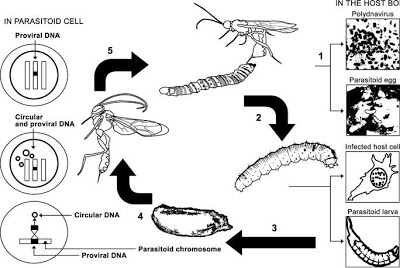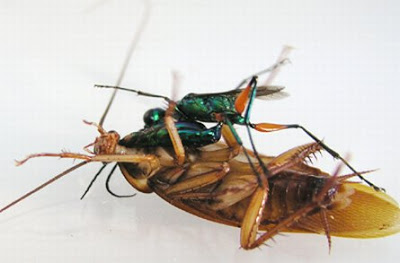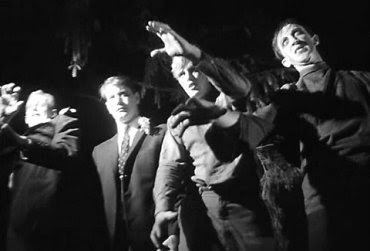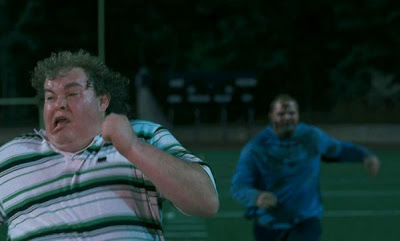 Zombies are almost always blamed on viruses.
Zombies are almost always blamed on viruses.
In movies, books and comics, if an explanation is given, it’s usually a virus.
Or radiation—that stuff is just like magic in movies, it can make animals grow, grant super powers and do incredible thing.
In nature, no virus has made a zombie that we know of—a hybrid of the Flu and Rabies would create a virulent Zombie virus.
However, there are zombies in nature after a sense.
Zombification is a strategy taken up by many parasitic organisms to fulfill their life cycles and breeding habits. They take over the brains and bodies of their hosts and force them to act against their will and/or infect others.
The last type of animal zombie maker has its own category because it’s inspired more than one classic monster.
Parasitoid wasps are several families off wasps which use other organisms to rear their young. This is not in the mockingbird sense, where the bird tricks other birds into rearing its young. This is in more of the Alien sense. The entire concept of the chest-bursting alien parasite is a million year old trick mother nature designed.
Most wasps, however, don’t let their victim walk around when they select them.
Usually, they paralyze them and hide the still-living body to protect it from predators. The most well-known wasp to do this is the tarantula hawk wasp, which, as the name implies, does this to tarantulas. But other wasps take a different strategy.
They make zombies.
Their victims range from ladybugs to caterpillars to spiders and any number of other arthropods and invertebrates. Many of these wasp larvae re-condition their host in some way to defend the larvae even as it devours their guts from the inside out.
Hymenoepimecis argyraphaga, which lays its eggs in the spider Plesiometa argyra, has the spider build a specific web to best host the cocoons of the wasp larvae once they gnaw their way out. Unlike the movies, these animals don’t punch their way out, but chew their way out. Slowly.
Dinocampus coccinellae larvae burst from the abdominal cavity of ladybird beetles, but keep the host alive as they weave the cocoon. The ladybird then spends the remainder of its life defending the cocoon until it hatches. Greivous wounds often cover many zombies to show their ‘undead’ status, but in nature, such magical solutions are not necessary.
The Emerald Cockroach Wasp (Ampulex compressa) targets roaches and its larva have a similar effect. Extensive studies were done with this insects and they showed that the roaches had severe mental handicaps, but knew how to run away and ran away from just about everything, though the effect is only or 72 hours, at which point it just becomes a lump of meat for the larva.
Glyptapanteles wasps attack caterpillars and have a similar effect on the hosts. The larva have the caterpillar switch tactics from generally trying to flee enemies, to violently thrashing about at anything that gets near it. It stops eating and just defends the little horrors devouring its guts. Sort of like living in a gingerbread house that can get up and punch burglars, murderers and little old ladies trying to cross the street. And even after gnawing their way out, like the Dinocampus victims, they defend the cocoons until they die or the wasps hatch.
Now imagine what happens if a wasp species infects humans.
Higher brain functions would be lost, and its only concerns would be keeping itself (and later the cocoons) safe. It would moan, perhaps, and attack anything that got to close with wild savagery. Biting and slamming anyone unfortunate to encounter it. This makes a very good zombie analogue with the added bonus of being able to host more than one larva at a time, eventually granting it a horde of wasps to both defend it and to infect others.
Pretty close to a Romero shambler, even though it would never actively hunt humans.
So far, only the video game franchise Dead Rising has used wasps as an origin for a zombie outbreak. These wasps are, of course, made really, really big—slightly larger than the Asian or Japanese Giant Hornet (Vespa mandarinia and Vespa mandarinia japonica). There are some odd quasi-magical things that occur with these wasps, however. The queens glow green at night, and the infected humans eyes glow red. This could be signs of a poisonous nature, but such abilities are not touched upon. Further, killing a hatched adult (“Queen”) in the presence of larva causes the larva to die.
For some reason. Biologically, it’s nine kinds of wrong. That sort of death inertia is best saved for battle droids.
Finally, like any good zombie, they crave flesh—even though it serves no purpose for the developing larvae.
The key point for all of these zombies is that they are alive. Their immune systems, hearts and brains still function—even if the brain is reduced in capacity and bent to a whim of an organism with little comparative computational power. This means that unlike most zombies, these beings can be killed by conventional means. A headshot is good, but not necessary.
This also applies for a virus derived zombie. They’re not dead, they’ve just had their bodies hijacked by another living thing with different priorities.
The zombies in the film Zombieland illustrate this well. While they also crave flesh for some reason, it is not just a headshot that kills them, a good shot to the chest can put them down almost as well. They ignore irrelevant things such as pain and fatigue all in the name of their new master.

















































































































